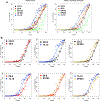PD-L1 Immunohistochemistry Comparability Study in Real-Life Clinical Samples: Results of Blueprint Phase 2 Project
- PMID: 29800747
- PMCID: PMC8386299
- DOI: 10.1016/j.jtho.2018.05.013
PD-L1 Immunohistochemistry Comparability Study in Real-Life Clinical Samples: Results of Blueprint Phase 2 Project
Abstract
Objectives: The Blueprint (BP) Programmed Death Ligand 1 (PD-L1) Immunohistochemistry Comparability Project is a pivotal academic/professional society and industrial collaboration to assess the feasibility of harmonizing the clinical use of five independently developed commercial PD-L1 immunohistochemistry assays. The goal of BP phase 2 (BP2) was to validate the results obtained in BP phase 1 by using real-world clinical lung cancer samples.
Methods: BP2 were conducted using 81 lung cancer specimens of various histological and sample types, stained with all five trial-validated PD-L1 assays (22C3, 28-8, SP142, SP263, and 73-10); the slides were evaluated by an international panel of pathologists. BP2 also assessed the reliability of PD-L1 scoring by using digital images, and samples prepared for cytological examination. PD-L1 expression was assessed for percentage (tumor proportional score) of tumor cell (TC) and immune cell areas showing PD-L1 staining, with TCs scored continuously or categorically with the cutoffs used in checkpoint inhibitor trials.
Results: The BP2 results showed highly comparable staining by the 22C3, 28-8 and SP263 assays; less sensitivity with the SP142 assay; and higher sensitivity with the 73-10 assay to detect PD-L1 expression on TCs. Glass slide and digital image scorings were highly concordant (Pearson correlation >0.96). There was very strong reliability among pathologists in TC PD-L1 scoring with all assays (overall intraclass correlation coefficient [ICC] = 0.86-0.93), poor reliability in IC PD-L1 scoring (overall ICC = 0.18-0.19), and good agreement in assessing PD-L1 status on cytological cell block materials (ICC = 0.78-0.85).
Conclusion: BP2 consolidates the analytical evidence for interchangeability of the 22C3, 28-8, and SP263 assays and lower sensitivity of the SP142 assay for determining tumor proportion score on TCs and demonstrates greater sensitivity of the 73-10 assay compared with that of the other assays.
Keywords: Checkpoint inhibitors; Companion diagnostics; Complementary diagnostics; Cytology; Immunooncology; Pathology.
Copyright © 2018 International Association for the Study of Lung Cancer. Published by Elsevier Inc. All rights reserved.
Conflict of interest statement
The remaining authors declare no conflict of interest.
Figures




Comment in
-
PD-L1 Testing in Lung Cancer: An International Pathologist's Initiative in an Unknown "Middle Earth".J Thorac Oncol. 2018 Sep;13(9):1239-1241. doi: 10.1016/j.jtho.2018.06.014. J Thorac Oncol. 2018. PMID: 30166010 No abstract available.
References
-
- Melosky B, Chu Q, Juergens R, Leighl N, McLeod D, Hirsch V. Pointed progress in second-line advanced non-small-cell lung cancer: the rapidly evolving field of checkpoint inhibition. J Clin Oncol. 2016;34:1676–1688. - PubMed
-
- Assi HI, Kamphorst AO, Moukalled NM, Ramalingam SS. Immune checkpoint inhibitors in advanced non-small cell lung cancer. Cancer. 2018;124:248–261. - PubMed
-
- Buttner R, Gosney JR, Skov BG, et al.Programmed death-ligand 1 immunohistochemistry testing: a review of analytical assays and clinical implementation in nonsmall-cell lung cancer. J Clin Oncol. 2017;35:3867–3876. - PubMed
Publication types
MeSH terms
Substances
Grants and funding
LinkOut - more resources
Full Text Sources
Other Literature Sources
Research Materials

